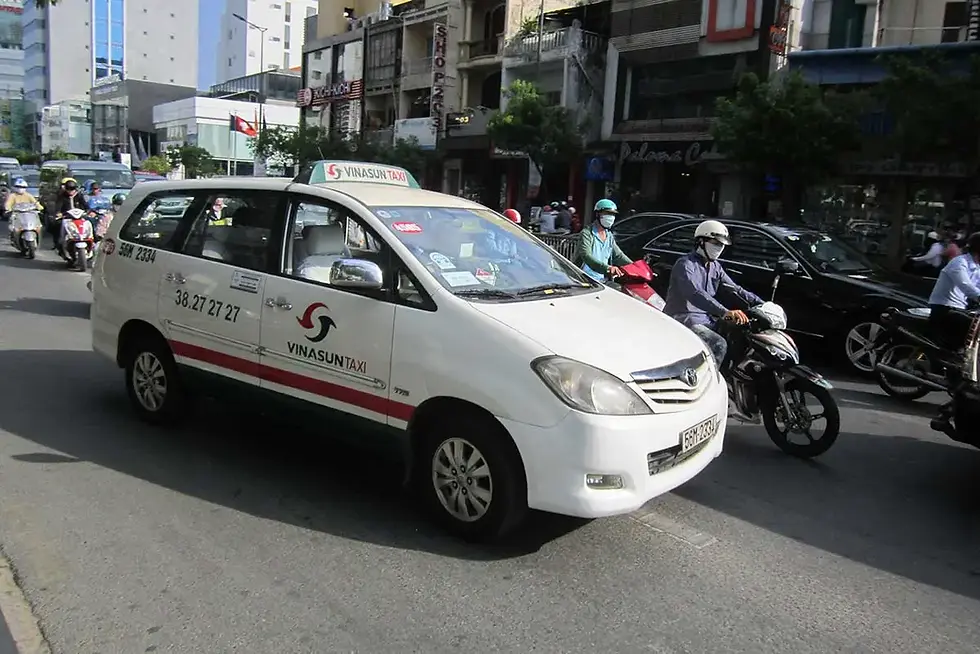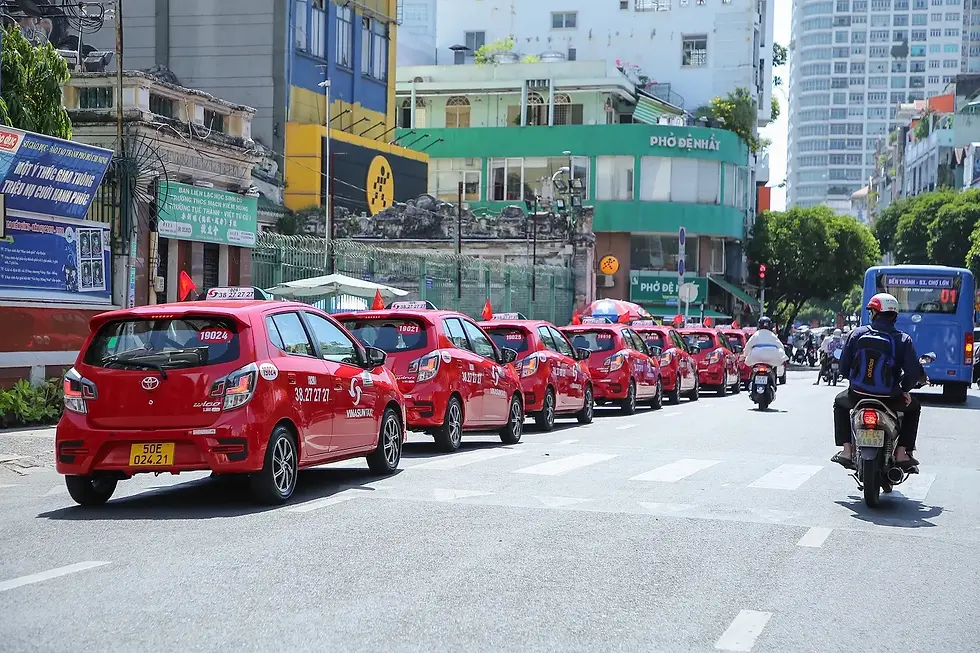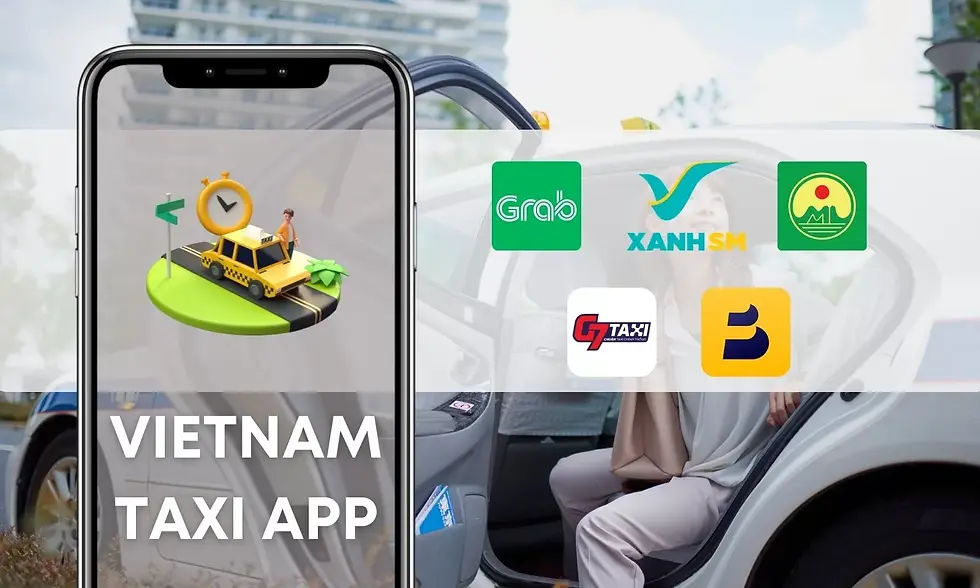Taxis in Vietnam – The Ultimate Guide: How to Travel in Vietnam Cheaply, Safely, and Stress-Free
- Damian Brzeski

- Sep 27
- 15 min read
Thick air, a river of scooters, and a tout already waving a "bargain" price—sounds like a recipe for stress? This guide will show you how to ride truly cheaply and safely in Vietnam: which taxis to take, how to avoid "fast" taxi meters, and when Grab beats the street.
Want to know how to spot a fake Vinasun by eye, how much you'll actually pay at the airport, and how to cross the street without rushing? Read on—you'll find simple rules that will save you money, stress, and… a few unnecessary trips around town.

First encounter with Vietnamese transport
The first moments after stepping out of the airport in Vietnam are a true collision with a different reality. The air is thick with humidity, the smells of street food, and exhaust fumes.
A constant, almost hypnotic concert of horns plays in your ears, and your eyes struggle to comprehend the flowing rivers of scooters that seem to move without any rules. It's chaos—exciting, at times overwhelming, yet utterly captivating.
In this world, transportation is more than just a way to get from point A to point B. It's an integral part of the journey, an adventure in itself.
If you're new to Vietnam, the hustle and bustle can be intimidating at first. How can you catch a taxi without getting ripped off?
Do apps work the same way they do at home? And how on earth do you cross a street that's never empty?
Don't worry, this article is your map and compass. I'll guide you through this maze step by step. From choosing the right company, to deciphering price lists, to mastering local etiquette.
This guide will make navigating Vietnam intuitive and allow you to fully enjoy this extraordinary country.
How to recognize an official taxi in Vietnam?
In the maze of vehicles, distinguishing trustworthy carriers from the numerous scammers is crucial. Fortunately, despite its apparent chaos, the Vietnamese transport market relies on trust in a few proven brands.
Over the years, travelers and locals have developed a simple strategy: stick to the two main players. Their popularity means they're most likely to be counterfeited, requiring a bit of vigilance on your part.
Two Major Corporations – Your Safe Choice
Most guides and local recommendations boil down to two names that are synonymous with safety and fair rates in Vietnam:
Mai Linh: This is the most recognizable chain in the entire country. You can recognize their vehicles by their distinctive, intense green color. Always look for the clear, official logo and headquarters phone number painted on the body.
Vinasun: The second leading company, especially popular in the south, including Ho Chi Minh City. Their taxis are mostly white with a distinctive red and green stripe. As in Mai Linh, it's crucial to verify the authenticity of the logo and official contact numbers.
How to spot a fake? A quick checklist.
Scammers know perfectly well that tourists are on the lookout for green and red-and-white cars. Their strategy is to create strikingly similar clones. Before you get in, take a look at a few details:
Name and logo: The devil is in the details. Scammers often use minor modifications, such as "Mai Lin" instead of "Mai Linh." The logo should be professionally printed, not look like a cheap sticker.
Phone Number: Official corporations have short, easy-to-remember numbers (e.g., 38 38 38 38). A long, random cell phone number on a door is a red flag.
Vehicle Condition: Taxis from reputable companies are usually relatively new and clean. A beat-up, neglected vehicle with makeshift markings should raise your suspicions.
Driver ID: In an official taxi, there should be a laminated ID on the dashboard with the driver's photo and details.
It's safest to hail a taxi from designated taxi ranks , especially at airports or large hotels. You'll often find employees in company uniforms coordinating the queue – a very good sign!

How Much Does a Taxi Cost in Vietnam? A Guide to Prices and Taxi Meters
Understanding how fees are calculated is crucial to avoid overpaying. The system is simple, provided you stick to one fundamental principle.
Rule #1: Always use a taximeter!
This is your sacred mantra. Repeat it before every ride: only with the taximeter on!
Any attempt to claim the meter is "broken" or offer a ride for a predetermined, inflated fare should be a sign to immediately leave the vehicle. When boarding a taxi in Mai Linh or Vinasun, turning on the meter is standard practice.
Price list structure
Tariffs in Vietnam typically have a three-tier structure, which you will find on a sticker inside the vehicle:
Opening price: A fixed amount for "slamming the door" and driving the first short distance (usually up to 1 km).
Per kilometer rate (up to approx. 30 km): After the initial distance, the meter charges a fee for each additional kilometer. The average price ranges from 12,000 to 15,000 VND (approx. 2-2.50 PLN / 0.45-0.55 €) .
Reduced rate per kilometre (over 30 km): For longer routes, after this threshold, the price per kilometre is lower.
Are there any hidden costs?
The issue of additional fees , such as toll roads or airport entry, can be ambiguous. Vinasun's official price lists clearly indicate that the customer is responsible for these costs.
It is safest to assume that reasonable tolls may be added, but it is worth being aware of their approximate amount.
Sample taxi fares in Vietnam (indicative prices)
Getting from the airport to the city center – how much will you pay on popular routes?
The first ride after arrival is when a weary traveler is most vulnerable to scams. Touts in the arrivals hall offer exorbitant fares. The key is to ignore them and head straight to the official taxi rank.
Hanoi (Noi Bai Airport - HAN)
Hanoi Airport is approximately 30 km from the city centre.
Taxi: A ride to the Old Quarter should cost 160,000-300,000 VND (approx. 27-50 PLN / 6-11 €) and take 30-45 minutes.
Grab: A great alternative, the price is known upfront and competitive.
Bus: The cheapest and most convenient option. The modern, air-conditioned express bus no. 86 runs to the city center for just 35,000 VND (approx. 6 PLN / 1.30 €) . The journey takes 60-90 minutes.
Ho Chi Minh City / Saigon (Tan Son Nhat Airport - SGN)
Saigon airport is much closer to the city center.
Taxi: Official taxis from the taxi stand will take you to District 1 for around 120,000-150,000 VND (approx. 20-25 PLN / 4.50-5.50 €) .
Grab: An extremely popular option, the cost is very similar to a taxi.
Bus: The cheapest choice. Line 152 costs just 5,000 VND (less than 1 PLN / 0.20 €) , but may lack space for large luggage.
Airport travel options – quick comparison
Grab & Co.: Why are apps your best friend in Vietnam?
Apps like Grab, Gojek, and Be aren't just technological innovations in Vietnam. They're a true revolution in trust. By giving passengers complete control and transparency, they've become the safest and most convenient form of transportation for many tourists.
Advantages of using Grab
After Uber withdrew from the region, Grab became the absolute leader. The benefits are invaluable:
Transparency: No more nervously checking the taximeter. The app displays the price upfront, eliminating the risk of fraud.
Security: You can see the driver's name, photo, license plate number, and ratings. The entire route is tracked by GPS.
Convenience: You order transport to any location, and payment can be made cashless after connecting your card.
How to get started? Practical tips
Download the app (Grab, Gojek) while still in Poland.
Create an account and add a card. Cards like Revolut and Wise work without a problem.
Buy a local SIM card with internet as soon as you arrive.
Always verify the car's registration number before entering!
While Grab is usually the best option, keep in mind that prices can skyrocket during peak hours or heavy rain. A traditional metered taxi can sometimes be cheaper.

What to do instead of a taxi? Explore Xe Ôm, Cyclo, and public transportation.
Xe Ôm (Motorcycle Taxi)
The ubiquitous scooters, known as xe ôm (pronounced "se om"), are an icon of Vietnamese cities and the fastest way to beat traffic jams. If you're hailing a driver off the street, ALWAYS negotiate the price in advance .
A short trip should cost no more than 50,000 VND (approx. 8 PLN / 1.85 €) .
A safer and cheaper option is to order a scooter through an app (GrabBike). The driver must provide you with a helmet.
Cyclo (Bicycle Rickshaw)
Today, three-wheeled rickshaws are primarily a tourist attraction. They're perfect for a leisurely ride through Hanoi's Old Town. Unfortunately, what's supposed to be a romantic experience ends up being a financial disaster for many tourists.
Set the price in advance, very precisely: whether it is a fee per person or per rickshaw, per hour or per ride.
City buses
This is by far the cheapest mode of transportation. A ticket purchased from the conductor costs pennies, often around 6,000-7,000 VND (approximately 1 PLN / 0.25 €) .
For navigation, it is best to use Google Maps, which is getting better and better at showing bus routes.
The Most Common Taxi Scams in Vietnam and How to Avoid Them
Catalog of typical traps
"Fast" taximeter: A manipulated meter that accrues fares at a frantic rate. If you see something wrong, ask to stop and get out.
"Scenic" Route: Deliberately taking a detour. Turn on your phone's navigation to control your route.
The problem with the rest: It's a classic. You pay with a large bill (e.g., 500,000 VND), and the driver claims he can't spend it. Always carry some change.
Fake Taxis : As described earlier – always check the logos and details.
What might surprise a European on a Vietnamese street?
Forget everything you were taught at home. Surviving Vietnamese traffic requires reprogramming your instincts.
The Art of Crossing the Street: This is the most important skill. Step onto the road and walk slowly, but with a firm, fluid gait. Don't run, stop, or reverse. A river of scooters will flow around you if you're predictable.
Horn as a Conversation: Horns are rarely an expression of aggression. They're a signal: "Look out, I'm coming," "I'm behind you."
Multi-purpose sidewalks: A sidewalk serves as a parking lot, kitchen, and dining area all in one. Pedestrians are often forced to walk along the edge of the roadway.
Other tips on how to avoid getting scammed in Vietnam
Traveling in Vietnam is a fantastic adventure, but it's worth knowing a few local tricks that scammers use on tourists.
The following tips, based on the experiences of other travelers, will help you stay alert and enjoy your trip without unnecessary stress.
1. Scooter Thieves – Keep Your Phone and Bag Close to You
Traffic in Vietnam is incredibly chaotic, and sidewalks often serve as an extra lane for scooters. This is an ideal environment for thieves, who can snatch a phone, camera, or purse from an inattentive passerby in the blink of an eye and disappear into the crowd.
How to protect yourself?
Hold your electronics securely: When taking photos or checking a map, hold your phone with both hands. When talking, cradle it in your hand so it's difficult to pull away.
Be aware of your surroundings: Watch out for scooters that get too close.
Don't leave valuables on the table: In street bars and cafes, keep your phone and wallet in your pocket or in a bag on your lap.
2. "Help" with payments - never let anyone rummage through your wallet
Vietnamese banknotes (dongs) can be difficult to understand at first – they have many zeros and are similar in color (e.g. 20,000 VND and 500,000 VND).
Some merchants, seeing your hesitation, may offer to "help" and take the appropriate banknote from your wallet themselves. This is a classic trap, where instead of 20,000 VND (about 3 PLN / 0.75 €), you end up with 500,000 VND (over 80 PLN / 18.50 €) .
How to protect yourself?
Get to know the banknotes: Take a moment to familiarize yourself with the denominations and their colors.
Stay organized: Sort the money in your wallet from smallest to largest.
Pay Yourself: Never, under any circumstances, let a stranger touch your wallet. Get change at chain stores like Circle K for larger denominations.
3. Street vendors and their tricks – always ask for the price BEFORE using
This is a golden rule in Vietnam. If the price isn't clearly stated, always ask before picking up anything or agreeing to a service. Otherwise, you could fall into one of the following traps:
Forced shoe cleaning: Someone points at your shoes, suggesting they're dirty or damaged. Before you know it, they're cleaning or "repairing" them, holding one shoe hostage. Finally, they demand an absurdly high payment. Advice: Ignore them and move on.
Donut treat you pay for: A street vendor offers you a single, fresh doughnut. After you take it, she insists you buy a whole bag of (often stale) sweets at an inflated price. Advice: Politely but firmly refuse free "treats."
Photo with baskets on your shoulders: You see a woman wearing a traditional hat with a bamboo sling. Before you know it, the sling is on your shoulders, the hat on your head, and her accomplice is taking a picture of you with your camera. Later, it turns out this "attraction" costs a fortune. Advice: Don't agree to such offers and don't give strangers your phone or camera.
4. Bar bill ripping
In popular tourist spots like Bui Vien Street in Saigon, it's easy to lose your cool. Beware of overcharged alcohol bills.
How to protect yourself?
Pay as you go: Instead of opening a receipt, pay for every beer you order immediately. This way, you'll have complete control over your spending.
Beware of "fresh beer" (bia hoi): Although it's incredibly cheap, pay attention to hygiene. Dishonest sellers sometimes refill mugs with leftovers from other customers.

Taxi etiquette, or tips and good manners
Is tipping allowed in Vietnam?
Generally, tipping is not part of traditional culture, but with the influence of tourism, it is becoming a nice gesture.
In taxis: The easiest way is to round up the bill. If the fare is 42,000 VND, paying 50,000 VND and not expecting change is considered polite. You can also leave an extra 10,000-20,000 VND (approximately 1.50-3.50 PLN / 0.40-0.75 €) .
In apps (Grab): After the ride is completed, the app often gives you the option to add a cashless tip.
What to do and what not to do?
DO: Say hello with a smile. A simple "Xin chào" (sin ciao) and "Cảm ơn" (kam on) when saying goodbye works wonders.
DO : Have your destination address saved in Vietnamese on your phone.
DO : Pay in local currency (VND) and have some change ready.
DON'T: Don't eat or drink in a taxi without asking permission.
DON'T : Don't slam doors – it's very rude.
DON'T : Don't show impatience in traffic jams. The driver has no control over them.
Your Vietnam Road Map
Navigating Vietnam with the right knowledge becomes an exciting adventure. The key to success is staying calm, alert, and willing to accept the local rules of the game.
Top 5 Golden Rules of Travel
Install Grab: It's your safest and most convenient choice in most cities.
Stick to Green and White: If you must take a traditional taxi, choose Mai Linh (green) or Vinasun (white). Always check for authenticity.
The Meter is Sacred: In a taxi, always ride with the meter running. For xe ôm and cyclo , ALWAYS agree on the price in advance.
Cross like a Vietnamese: Walk slowly, smoothly, and predictably. The river of traffic will pass you by.
Have Change: Always carry smaller denominations ( 10,000, 20,000, 50,000 VND ) with you – it will make your life easier.
Treat every journey, whether in an air-conditioned taxi or on the back of a speeding scooter, as an opportunity to see the real, vibrant Vietnam. With this guide in hand, every path lies open to you.
FAQ: Taxis in Vietnam at a glance
Are taxis in Vietnam safe for tourists?
Yes, as long as you use reputable companies like Vinasun Taxi or Mai Linh, or taxi apps like Grab . Always avoid random, unlicensed taxis on the street to avoid being scammed. Choosing a reputable Vietnam taxi gives you peace of mind.
What is the best taxi company in Vietnam?
The two most trusted are Vinasun Corporation (especially in the south, such as Ho Chi Minh City ) and Mai Linh (available nationwide). Both of these companies offer high-quality, standard taxis and fair prices, making them the best taxis for tourists.
Which is better: the Grab app or traditional taxis?
Grab (and other taxi apps ) often wins with price transparency and ease of booking. However, during peak hours or in rainy weather, a traditional taxi service from Vinasun Taxi with a meter may prove cheaper. It's worth comparing both options.
What is the safest way to order a taxi from the airport in Hanoi or Ho Chi Minh City?
The key rule: ignore the touts. After collecting your luggage, go to an official, marked taxi rank and hail a Mai Linh or Vinasun Taxi . Alternatively, order a Grab through the app—it's a reliable and often cheaper transfer service .
Is a taxi from the airport more expensive than in the city?
Generally, Vietnam taxis charge the same price per kilometer, but a small, official airport fee may be added to the taxi fare from the airport . However, the total cost of the ride from an official taxi stand is significantly lower than that offered by touts.
What is the approximate price per kilometer in a Vietnamese taxi?
The standard rate in Vietnam ranges from 12,000 to 17,000 VND per kilometer. Always make sure the driver has turned on the taximeter. This way, you'll know the actual price of the ride.
Will I have a problem ordering a taxi with luggage?
Absolutely not. Standard sedans can accommodate two medium-sized suitcases. If you have more luggage, Vinasun Taxi offers larger, 7-seater vans. You can also choose a larger car (GrabCar 7) through the Grab app, so taking a taxi with luggage isn't a challenge.
What are motor taxis (xe ôm) and are they worth using?
This is the fastest and most popular mode of transportation in Vietnam's congested cities. The safest way to book a motorbike taxi is through the Grab app (GrabBike service), which guarantees a verified driver and a helmet. It's a great option for short trips.
Is it okay to tip taxi drivers in Vietnam?
It's not mandatory, but it's a nice gesture to round up your bill. A good taxi driver who was helpful and drove safely will certainly appreciate a small tip as a token of your satisfaction .
Is it worth booking a taxi in Vietnam in advance through services like Kiwi Taxi?
Kiwi Taxi is an international platform that allows you to book a taxi with a driver online. It's convenient, but typically significantly more expensive than hailing a Vinasun Taxi or ordering a Grab on the spot. It's an option for those who value maximum comfort and predictability.
What does the taxi payment service look like? Can I pay by card?
Cash is king in traditional taxis – always carry some change! Taxi apps like Grab let you add a payment card and make cashless payments, which is incredibly convenient.
Is it worth using taxis ordered by the hotel?
A hotel taxi is a convenient and safe option. The staff will arrange a reliable taxi for you, offering transportation assistance . However, this service is usually more expensive than ordering a Grab or hailing a taxi from the street.
How to deal with the language barrier when ordering transport in Vietnam?
The best taxi drivers from travel agencies may know basic English. However, the most reliable way to get a taxi with barrier-free communication is the Grab taxi app , where you enter your destination on a map and the driver receives detailed directions.
Are there luxury taxis available in Vietnam?
Yes, in major cities like Ho Chi Minh City, you can book a luxury taxi . The Grab app offers higher-end rides (GrabCar Plus/Business). Many 5-star hotels also offer their own luxury limousines as a private transfer service .
Which taxis are best in popular resorts like Nha Trang?
In Nha Trang , as throughout Vietnam , the most reliable option is the green taxi company Mai Linh, which has a very strong presence there. Grab is also available and very popular.
What is the most common problem with Vietnam taxis and how to avoid it?
The biggest threat comes from scammers impersonating well-known companies like Vinasun Corporation . Always carefully check the logo, colors, and phone number on the door. Using a taxi app that verifies drivers completely eliminates this risk.
How to find a taxi with local drivers who know the city well?
Virtually every driver, both with Vinasun Taxi and the Grab app, is a local. Grab's rating system is a plus – you can check other passengers' reviews, guaranteeing a quality taxi and a driver who knows the city's geography.
Can the Grab app let you request a ride for someone else?
Yes, this is one very useful feature. You can order a taxi for a friend by entering their location and destination, and then share the driver's details with them. It's a great example of a flexible service for customers .
Can I hire a taxi with a driver for the whole day?
Of course. Many taxi companies and Grab drivers offer this option. The price for a few hours or a full day should be agreed in advance. This is an excellent option for exploring surrounding cities, such as the Cu Chi Tunnels near Ho Chi Minh City .
Why is Vinasun Taxi recommended so often in Vietnam?
Because Vinasun Corporation has built a brand based on trust, honest taxi meters, and a large fleet of vehicles over the years, guaranteeing a taxi with experience . By choosing Vinasun Taxi , you are choosing a reliable and proven taxi service .
































































Comments